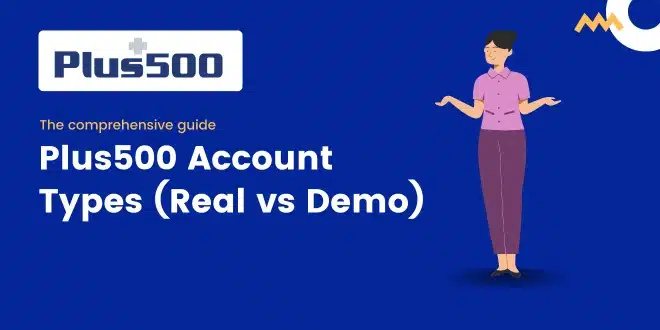Opening a Plus500 account is a popular first step for people interested in trading forex, stocks, commodities, indices, and cryptocurrencies.
Whether you’re completely new to trading or you’ve tried a few platforms before, understanding the difference between real accounts and demo accounts on Plus500 can help you avoid common mistakes and start off with confidence.
This guide breaks down everything you need to know about these two account types — how they work, who they’re for, and what to expect — so you can make the best choice for your trading goals.
What is a Plus500 demo account?
A demo account on Plus500 is a practice account where you trade using virtual money instead of real funds. It’s free, risk-free, and designed to help you learn how trading works and get comfortable using the platform.
Key features of the demo account
- Free to open with no deposit required.
- Funded with virtual money.
- Provides access to all tradable assets: forex pairs, stocks, commodities, indices, cryptocurrencies.
- Simulates real market conditions so you can practice placing trades.
- Lets you test tools like stop-loss, take-profit, and leverage settings.
Why beginners love it
- You can learn how Plus500 works before risking real money.
- You can practice basic trading strategies.
- You can explore how different assets behave in different market conditions.
- There’s no risk of losing money.
Many new traders start with Plus500’s demo account because it’s simple to access — you can toggle between demo and real mode directly in the platform without creating a second login.
What is a Plus500 real account?
A real account is where you trade using your own money. Every profit adds to your balance, and every loss reduces it. This is where trading becomes real — emotionally and financially.
Key features of the real account
- Requires a minimum deposit (around $100, but this can vary by country and payment method).
- Gives access to real-time market prices and execution.
- Available for the same asset classes: forex, stocks, commodities, indices, and crypto CFDs.
- Subject to spreads, overnight fees (swap), and possible currency conversion fees.
- Requires identity verification (KYC) before withdrawing funds.
Why traders move to real accounts
- Real profits — but also real losses.
- Experience how markets behave under live conditions.
- Learn to manage emotions like fear and greed, which don’t exist in demo trading.
- Practice applying risk management strategies with your actual money.
Key differences between demo and real accounts
- Funds: Demo uses virtual money; real uses your own deposit.
- Risk: Demo is 100% risk-free; real carries full financial risk.
- Market conditions: Both use live market data, but real accounts may experience slippage or slower order execution during volatility.
- Emotional impact: Demo trading is stress-free; real trading can trigger emotional reactions that affect decisions.
- Verification: Demo requires no documents; real accounts need identity and address verification.
Insights from real traders
On forums like ForexFactory, Trustpilot, and Reddit’s r/Forex, users often discuss how the trading experience feels different between demo and real accounts.
- Confidence and panic. Some beginners say they felt confident in demo mode, only to panic when trading real money because they weren’t prepared for the emotional pressure.
- Intermediate traders often mention slightly slower execution speeds in real accounts during high-volatility events like major economic reports. This is common with many brokers, not just Plus500.
- A recurring tip from experienced traders: Treat your demo account like real money if you want it to be good practice. Take your demo trading seriously — don’t just place random trades for fun.
Market-specific details
EU and UK
- Leverage limits for retail traders: 1:30 for forex and lower for other assets, following ESMA regulations.
- Negative balance protection: Retail traders in the EU and UK can’t lose more than their deposit.
Global (outside EU/UK)
- Leverage may be higher in certain non-EU markets (up to 1:300 in some cases).
- Regulations and protections depend on the specific entity you open your account with — Plus500 has different legal entities for different regions.
Beginners’ note
If you’re outside regulated markets, double-check your protections. Some regions don’t offer negative balance protection, meaning it’s possible to lose more than your deposit in extreme cases.
Who should use each account type?
Demo account is best for:
- Complete beginners learning to trade.
- Anyone testing the Plus500 platform.
- Traders experimenting with new strategies.
- People learning to manage leverage and order types.
Real account is best for:
- Traders who are ready to risk real money.
- People who want to develop emotional discipline.
- Anyone who understands basic trading strategies and risk management.
- Intermediate traders looking to grow their skills with live conditions.
Final thoughts
Choosing between a demo account and a real account on Plus500 depends on where you are in your trading journey. The demo account is a fantastic learning tool, but the real lessons begin when you start trading with your own money. Both accounts offer valuable experiences — the key is to know when you’re ready to make the switch.
FAQs
1. Do I need to deposit money to open a demo account?
No. Plus500’s demo account is free and requires no deposit.
2. Can I switch between demo and real accounts?
Yes. Plus500 lets you toggle between demo and real mode directly in the platform.
3. How long can I use the demo account?
There’s no time limit, but inactive demo accounts may be closed after a period of inactivity.
4. Does the demo account match real trading conditions?
Mostly — the pricing, assets, and tools are the same. However, execution speeds and slippage may differ slightly, especially during major market events.
5. Is verification required for demo accounts?
No. Only real accounts require ID and address verification.
6. What’s the minimum deposit for a real Plus500 account?
It’s usually around $100, but this can vary based on your region and deposit method.
- 7. Can I lose more than my deposit in a real account?
In the EU/UK: No, due to negative balance protection. - In some non-EU regions: It’s possible if your region doesn’t offer this protection.


